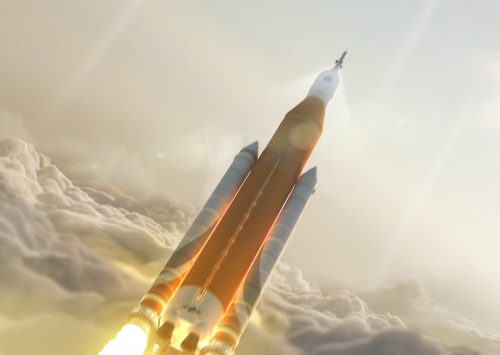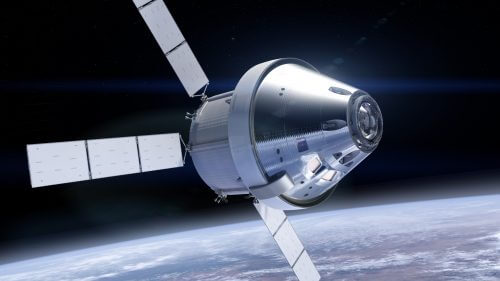The acting director of NASA, Robert Lightfoot, said that he ordered to examine the practicality and consequences of introducing the first manned flight of the Orion spacecraft, which will send astronauts into orbit around the moon, to the first flight of the SLS heavy launch vehicle, which NASA is currently developing. According to the official plan, which has not yet changed, the first flight of the launcher should be carried out in 2018 as an unmanned test flight, and only in 2021 to launch astronauts for the first time.

NASA's acting administrator, Robert Lightfoot, Sent yesterday A memorandum to the agency's employees in which he ordered to examine the practicality and consequences of a proposal to add a team of astronauts to the first flight of the SLS launcher, which the agency is currently developing. Such a move could push the current launch target of 2018 to a later date, perhaps 2019 or 2020. While this may not be related, it is interesting to note that both of these dates fall within the current term of the new US President, Donald Trump.
Robert Lightfoot, the agency's top civilian official, became NASA's acting administrator after the departure of previous administrator Charles Bolden, when Donald Trump took office on January 20.
The SLS launcher (abbreviation of the rather banal name Space Launch System, "launch system into space") is a heavy launcher that the American agency is currently developing, based on the technology used by the space shuttles, to launch astronauts into "deep space" - first to an orbit near the moon And in the future even to Mars. In addition to the new launcher, NASA is also developing the Orion spacecraft, which in its design resembles the Apollo spacecraft that brought astronauts to the moon.
According to the official plan, which has not yet changed, the first flight of the SLS launcher should be carried out as a test flight in 2018, during which an unmanned Orion spacecraft will be launched into orbit around the moon. The first manned flight was planned to take place only on the second flight of the launcher, in 2021 at the earliest. A report compiled by sources outside of NASA even warned that the first manned flight may be delayed to 2023.
In the Lightfoot memorandum Wrote: “I asked Bill Gerstenmeier [NASA's associate director for manned spaceflight] to initiate a study that would examine the feasibility of adding a crew to Exploration Mission-1, the first combined flight of SLS and Orion. I know that the challenges that accompany such a proposal, such as examining the technical feasibility, allocating required resources and of course the additional work, will require a different target date for the launch. At the same time, I also want to hear about the opportunities the proposal may present to accelerate the effort toward the first manned flight, and what it takes to accomplish the first step in pushing humanity deeper into space. The SLS and Orion missions, together with those secured by unprecedented private investment in space, will help NASA and America uncover these secrets and ensure this nation's global supremacy in space exploration."
If the proposal is approved, it could raise safety questions for the US agency, since the first flight of the SLS launcher will actually also be the first flight of astronauts on it. However, this is not unprecedented, and the same was done in the space shuttles - the first launch of a space shuttle took place in 1981, with the launch of the space shuttle Columbia with two astronauts on board.
Another problem the agency will face is regarding the second and upper stage of the SLS launcher, which is not yet approved for manned launches. The first stage of the launcher uses the proven and safe engines used by the space shuttles. However, its upper stage is not yet ready at all. According to current plans, the first unmanned test flight in 2018 will use a temporary upper stage, which is used by Delta 4 launchers. Such an upper rocket stage is not approved for launching astronauts. By the time of the first manned flight in 2021, the agency should develop the final upper stage of the SLS, known as the Exploration Upper Stage. It will be based on the same Delta 4 upper stage, but will be more powerful and will use four rocket engines instead of the original one.

The agency had previously planned to also make the temporary upper stage usable for manned flights, but US Congress Forbid her To do so and instead demanded that you devote more resources to the development of the final upper stage, and finish its development in time for the manned launch in 2021.
Now, with the new proposal, it is unclear how the agency will solve the problem. If it wants to use the final upper stage already on the first flight of SLS, it will have to invest a lot of resources and money to advance its development. Alternatively, it could go back and try to make the temporary upper stage usable for manned flights.
Another issue that the agency will have to address is the fact that the Orion spacecraft model, which is already under construction for the first test flight, was designed for an unmanned flight, and does not have the systems to support the lives of the astronauts that are supposed to be in a manned Orion spacecraft. Despite this, an engineer at NASA who was interviewed He told the website Ars Technica that with a budget increase it is possible to solve the problem using basic and older life support systems, which have already been proven safe in the past.
A spokesman for Lockheed Martin, which builds the Orion spacecraft, A message In a statement to the Space News website: "Lockheed Martin will assist NASA in its testing to determine the feasibility of flying a crew on Exploration Mission 1. We will examine the possibility of accelerating the design of the remaining crew systems, and we will also examine potential technical and schedule challenges, and how to deal with them."
In his memo, Lightfoot also mentioned the recent debate about the Trump administration's policies regarding the space agency and the US space program. Many reports (For example on the Politico website) dealt with the question of whether the new administration intends to abandon the government programs for space exploration and prefer private partnerships. Among other things, the question arose as to whether there is a place to develop such an expensive launcher as the SLS, whose development cost so far stands at billions of dollars, while private companies are developing their own heavy launchers that may be cheaper and more innovative. A striking example of such a launcher is the "Falcon Heavy" launcher that SpaceX plans to launch for the first time this year - it will actually consist of three first stages of Falcon 9 connected together, with the upper rocket stage and the launched payload on the middle one.
In a memo, Lightfoot wrote: "There is a lot of speculation in the public discourse about NASA being pushed in two directions - what was in the past and what we want to do now. At NASA, it's a "both" and not an "or" proposition. To get where we want to go, we need to work with the companies that will be represented at the SLS and Orion supplier conference, and also with those industry partners who work with us across the country - and all of them have a long-term perspective on this work. We must work with everyone to ensure our leadership in space - and we will."
Although the Trump administration has not yet declared what its space policy will be and it is not clear which way it will choose to steer the space agency, it should be remembered that SLS and Orion have quite broad support in the US Congress. Congress was the one to begin with forced the previous president, Barack Obama, to develop a heavy launcher, after it canceled the development of the heavy launchers (of the "Venom" type) and the "Constellation program" initiated by his predecessor, George Bush. One of the candidates the carriers To serve as the next NASA administrator, the Republican member of the House of Representatives from the state of Oklahoma Jim Bridenstine, He declared He also for his support in the development of the government's launcher and spacecraft.
The new proposal to advance the first manned launch of the SLS may be designed to please Trump. A manned launch into orbit around the moon, near or perhaps even in 2019, when the United States will mark the fiftieth anniversary of the Apollo 11 manned landing on the moon, could be an important victory image for Trump, thus encouraging him to keep developing the launcher.

2 תגובות
Willing to spend some astronauts so as not to lose budgets. Because of such management the two previous accidents happened.